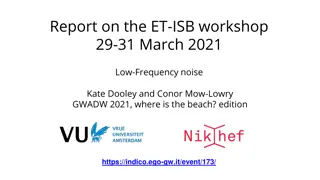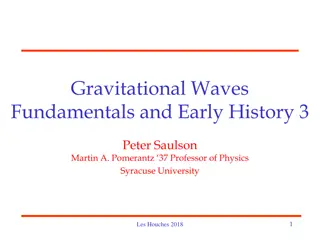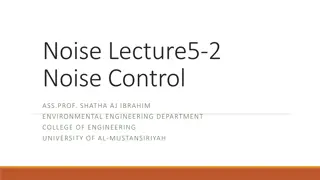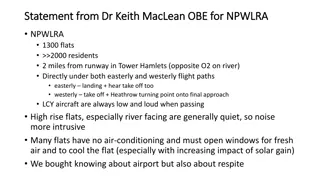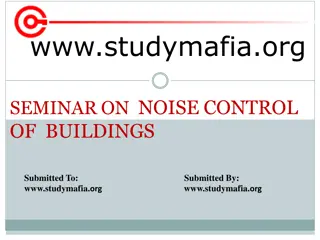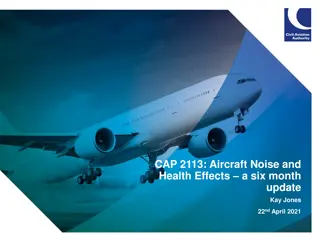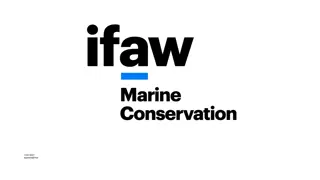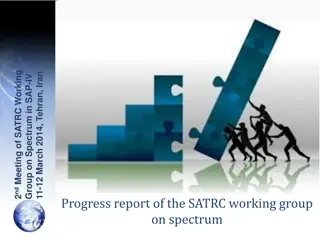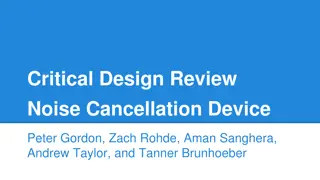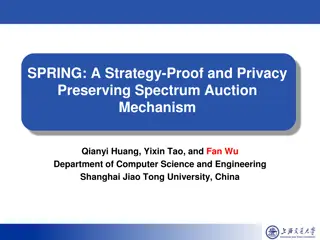Frequency Weighting in Noise Pollution Measurement
Frequency weighting is essential in noise pollution measurement to reflect how the human ear perceives noise. The A, C, and Z weightings are commonly used to represent different frequency responses. A-weighting covers the audible frequencies where the human ear is most sensitive, while C-weighting i
4 views • 7 slides
SMuRF: SLAC Microresonator RF Readout
SMuRF group at SLAC developed a cutting-edge RF readout system for cryogenic micro-resonators used in research. The system features cold resonators tuned with TES current and a flux ramp to eliminate 1/f noise. Key technical challenges include noise, linearity, wide bandwidth, and computation power.
5 views • 16 slides
Noise in Communication Systems
Noise in communication refers to unwanted energy that interferes with signal reception and transmission. It can be categorized as external or internal noise, each with various subtypes like atmospheric noise and shot noise. Recognizing and managing different types of noise is essential for ensuring
2 views • 8 slides
Spread Spectrum Communication Systems
Spread spectrum techniques involve spreading a signal over a wide bandwidth for various reasons, such as secure communication, resistance to interference, noise, and jamming. This summary introduces Direct Sequence Spread Spectrum (DSSS), Frequency Hopping Spread Spectrum (FHSS), Time Hopping, and h
1 views • 25 slides
Occupational Noise Exposure and Hearing Conservation Training Program
Learn about the Occupational Noise Exposure and Hearing Conservation Training Program presented by the Office of Environmental Health and Safety at ECU. This program aims to educate workers about the risks of noise-induced hearing loss, the importance of prevention, and the selection of appropriate
1 views • 20 slides
Noise in RF Integrated Circuits: Thermal and 1/f Noise
Noise, an unwanted input, limits a system's ability to process weak signals. Sources of noise include random noise in resistors and transistors, mixer noise, undesired cross-coupling noise, and power supply noise. Thermal noise, caused by thermal agitation of charge carriers, is also known as Johnso
1 views • 49 slides
Insights from ET-ISB Workshop on Low-Frequency Noise and GWADW 2021
The ET Instrument Science Board held a workshop focusing on addressing key challenges related to low-frequency noise in gravitational wave detectors. Experts discussed topics such as mirror temperature, dealing with low-frequency noise realities, and facility limits. The workshop highlighted the sig
0 views • 13 slides
Advanced Understanding of Low-Frequency Noise in Instrumentation
Understanding low-frequency noise in instrumentation has advanced significantly, emphasizing the need for an integrated approach to predict and mitigate such noise. Recent studies show that low-frequency noise in third-generation instruments is exceptionally better than in second-generation detector
0 views • 11 slides
Noise in Communication Systems
Noise in communication systems refers to unwanted signals that interfere with desired signals, originating from various sources such as interference from human-made sources and naturally occurring random noise. This noise can arise from factors like cross talk, power supplies, ignition systems, and
1 views • 19 slides
Gravitational Waves: Basics and Detection Challenges
Exploring gravitational waves fundamentals, early history, and challenges in detection. Covers topics like interpreting noise power spectrum, shot noise in interferometers, radiation pressure, and quantum limits. Illustrates the importance of noise spectrum analysis and mathematical operations in un
0 views • 42 slides
Protect Your Hearing: Strategies for Prevention
Strategies for minimizing noise-related threats in operational environments are crucial to prevent permanent hearing loss. Understanding the risks of loud noise exposure, utilizing hearing protection, undergoing regular audiometric testing, and maintaining noise records are essential components of t
1 views • 22 slides
Noise Pollution: Sources, Terminology, and Measurement
Noise pollution is defined as undesirable sounds that disrupt human and animal life. This article explores the sources of noise pollution, terminology used in its measurement, and its impact on urban environments. Major sources include traffic noise, industrial machinery, and household activities. U
1 views • 26 slides
Noise Control Methods in Environmental Engineering
Explore the concepts of noise control in environmental engineering, focusing on mufflers, reactive mufflers, and noise control in the transmission path. Learn about absorptive and reactive mufflers, their principles, and applications. Discover how barriers and panels can effectively reduce noise tra
0 views • 9 slides
Concerns Regarding Airplane Noise Impact on Residents in Tower Hamlets
Dr. Keith MacLean OBE provides a statement on the impact of airplane noise on over 2000 residents living in 1300 flats within a 2-mile radius of a London airport in Tower Hamlets. The residents face challenges with noise disturbance from easterly and westerly flight paths, with proximity to both lan
0 views • 10 slides
Noise Control Measures and Community Preferences at the Corn Exchange
Various images and references discuss the history of amplified music events at the Corn Exchange, noise complaints leading to control methods by the FTC, impacts on events and community preferences post-control, and survey findings on participant demographics, noise effects, and desired public event
0 views • 19 slides
Noise Control Strategies for Buildings: A Comprehensive Seminar Overview
Explore the impact of noise on health, methods to control noise in buildings, and various techniques including room acoustics, wall and floor construction, space planning, HVAC soundproofing, and more. Understand the importance of noise reduction for overall well-being and effective sound management
1 views • 20 slides
Noise Occupancy Study of FEI4B Quad Module: Troubleshooting and Solution
This study delves into the noise occupancy of the FE-I4B chips on the quad module mounted on the Stavelet, addressing unexpected noise increases, problem tracing, and cross-checking between USBpix and RCE. Early studies pinpoint temperature control and suspected unstable grounding. The comparison be
0 views • 21 slides
Bandwidth, Channel Capacity, and Noise in Communication Networks
Bandwidth is a crucial aspect of network capacity, describing the data transfer speed and carrying capacity of a channel. Channel capacity involves factors like data rate, bandwidth, noise, and error rate. Noise sources include thermal noise, impulse noise, and delay distortion, impacting signal qua
0 views • 5 slides
IEEE 802 Spectrum Planning: Proactive Approach for Improved Spectrum Management
Exploring the need for proactive spectrum planning in IEEE 802 to better manage the complex process of meeting spectrum needs efficiently and effectively. Delving into the challenges of spectrum allocation, sharing, and optimization to ensure that standards have the RF spectrum necessary for their r
0 views • 9 slides
Spectrum Databases and PAWS Parameters
Explore the world of Spectrum Databases and PAWS parameters, which provide essential information about available spectrum, permissible power levels, regulatory domains, geolocation data, and more. Learn about typical deployments, data types, and spectrum scheduling to enhance your understanding of s
0 views • 16 slides
Aviation Noise Management Strategies in Sweden
Aviation noise management in Sweden focuses on a balanced approach with four principal elements: noise reduction at the source, adherence to ICAO noise standards, differentiated landing fees, and operating restrictions. Competent authorities such as the Swedish Environmental Protection Agency and Sw
2 views • 4 slides
The Impact of Aircraft Noise on Health - Recent Update
This report provides a six-month update on recent research findings regarding aircraft noise and its effects on health. Saucy et al. studied the association between aircraft noise exposure and cardiovascular mortality, particularly at night, with significant findings related to increased odds of nig
0 views • 20 slides
Noise Pollution: Sources, Effects, and Control
Noise pollution is a significant environmental issue resulting from unwanted sounds in various settings. This article delves into the properties of sound, measurement techniques, sources of noise, effects of noise exposure, and strategies for control and mitigation, shedding light on the impact of n
1 views • 16 slides
Addressing Underwater Noise Pollution in EU Waters: Urgent Action Needed
Whales, dolphins, and other marine life are severely impacted by underwater noise pollution caused primarily by shipping activities in EU waters. Urgent implementation of stricter regulations based on IMO guidelines is essential to reduce noise levels and protect marine ecosystems. Recommendations i
0 views • 4 slides
Noise Figure Analysis in Hybrid Beamforming Systems
This document discusses the theoretical study of noise figure (NF) and gain in hybrid beamforming systems, focusing on the impact of additional RF blocks, such as phase shifters and combiners, on noise figure calculations. It explains how the received signals from multiple antennas are phase-correct
0 views • 11 slides
Progress report of the SATRC working group on spectrum
The SATRC Working Group on Spectrum convened for their 2nd meeting in Tehran, Iran in March 2014. The group focused on spectrum management, monitoring, sharing, and efficient use for various services in the region. Key discussions included regional spectrum requirements, mobile broadband availabilit
0 views • 21 slides
Critical Design Review Noise Cancellation Device
This project aims to create a portable device for reducing HVAC equipment noise levels. With objectives like noise reduction by at least 10 dB in specific frequency ranges, this device will utilize key technologies such as Teensy, Electret Microphone Amplifier, and more. The noise cancellation algor
0 views • 13 slides
Noise Pollution and Its Effects
Noise pollution is the unwanted presence of sound that can have detrimental effects on both humans and animals. As urbanization and industrialization increase, so does the threat of noise pollution. Sources of noise pollution include automobiles, factories, and loudspeakers. It is measured in decibe
0 views • 12 slides
Spectrum Sharing Techniques Overview
This overview discusses the regulation and technical enablers for sharing spectrum, focusing on licensed spectrum, dynamic licensed access, and spectrum sharing techniques. Learn about the importance of dynamic spectrum sharing and RAN sharing, as well as the need for a pan-European framework. Explo
1 views • 21 slides
Approximately Learning: Noise, Model Selection, Dimensionality Reduction
In Module II, explore Probably Approximately Learning (PAC), Noise, Model Selection, and Generalization. Understand the impact of noise on data, the sources of noise, and how noise affects learning outcomes. Discover methods like Principal Component Analysis and subset selection to address noise in
0 views • 133 slides
Understanding Different Types of Noise and Environmental Noise Propagation
Learn about continuous, intermittent, and impulsive noise types produced by various sources like machinery and vehicles. Explore the factors affecting environmental noise propagation, including distance, atmospheric absorption, and reflections. Gain insights into measuring noise levels and understan
0 views • 9 slides
Noise Considerations in Satellite Communications Engineering Lectures
Explore the fundamentals of noise considerations in satellite communication links, covering external and internal noise sources, thermal noise, signal-to-noise ratio, and various losses affecting satellite communication systems.
0 views • 16 slides
FCC Spectrum Auctions and Radio Spectrum Allocation
Explore the FCC's use of auctions for radio spectrum licenses in the US. Learn about the theory and practice behind spectrum auctions, the history of allocation methods, Coase's influence, and the significance of spectrum auctions for consumers, firms, and governments. Delve into the complexities of
0 views • 45 slides
RSPG Work Programme 2024/2025: Spectrum Policy Updates & WRC Reviews
Explore the Radio Spectrum Policy Group's work program for 2024/2025, including peer reviews, WRC outcomes, and future spectrum utilization plans. Stay informed on strategic spectrum matters and upcoming WRC-27 themes to shape EU spectrum policies effectively.
0 views • 10 slides
Privacy-Preserving Spectrum Auction Mechanism: SPRING Strategy
Explore SPRING, a Strategy-Proof and Privacy-Preserving Spectrum Auction Mechanism developed by Qianyi Huang, Yixin Tao, and Fan Wu from Shanghai Jiao Tong University. The mechanism addresses the challenges of protecting bidder privacy in spectrum auctions, providing a innovative solution for effici
0 views • 28 slides
Innovative Spectrum Technologies in DoD Spectrum Access Research
Discover how the Department of Defense is advancing spectrum access through innovative technologies, collaboration with industry, and a focus on EMS efficiency and resilience. Learn about the National Spectrum Consortium and the ongoing Spectrum Access Research and Development Program to improve ele
0 views • 4 slides
Canada Spectrum Outlook 2025: ISED Regulatory Framework & Spectrum Management
Discover the comprehensive overview of Canada's spectrum outlook for 2023-2027, including insights on the regulatory legal framework, electromagnetic spectrum management, and ISED's priorities. Gain valuable information on spectrum demand, planned releases, and addressing technical issues for servic
0 views • 17 slides
Learning-Based Spectrum Occupancy Prediction Exploiting Multi-Dimensional Correlations
Explore the concept of multi-dimensional spectrum occupancy prediction in wireless networks. Discover methods leveraging time, frequency, and space correlations for accurate spectrum prediction and efficient spectrum utilization. Validate the feasibility through experimental measurements. Address th
0 views • 12 slides
MOSFET Noise in Active Devices: Schematics and Expressions
Explore the schematization and expressions of noise in active devices such as MOSFETs, covering thermal noise, flicker noise, and the relationship between noise expressions. Understand the equivalent gate noise and the equivalence between output-referred and input-referred noise models in microelect
0 views • 12 slides
Proposed Spectrum Resource Measurement Report Structure for IEEE 802.15
This document proposes a structured approach for spectrum resource measurement reports in the context of IEEE 802.15 working group for Wireless Personal Area Networks (WPANs). It outlines the guidelines for Spectrum Resource Measurement (SRM) requests by Spectrum Resource Management Entities (SRME)
0 views • 5 slides






